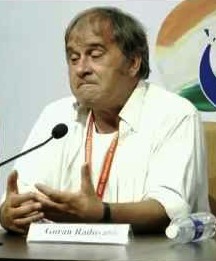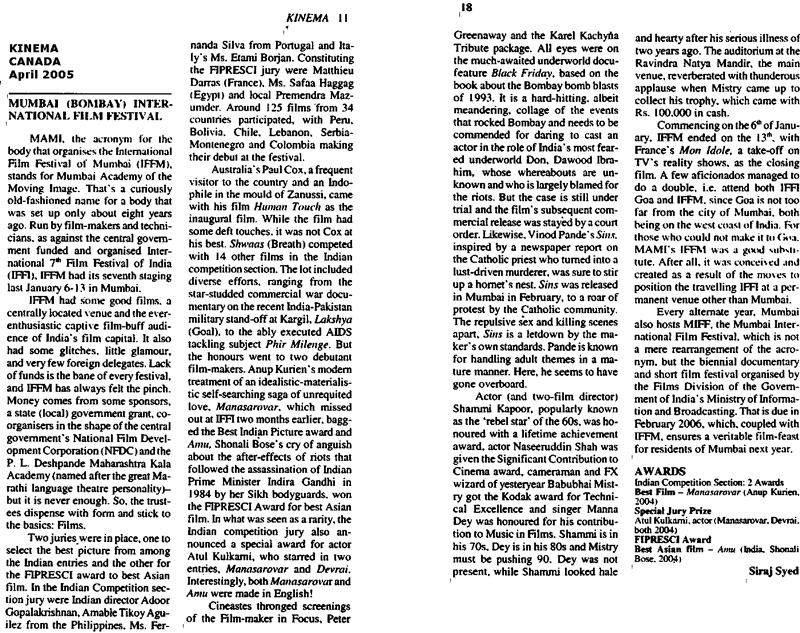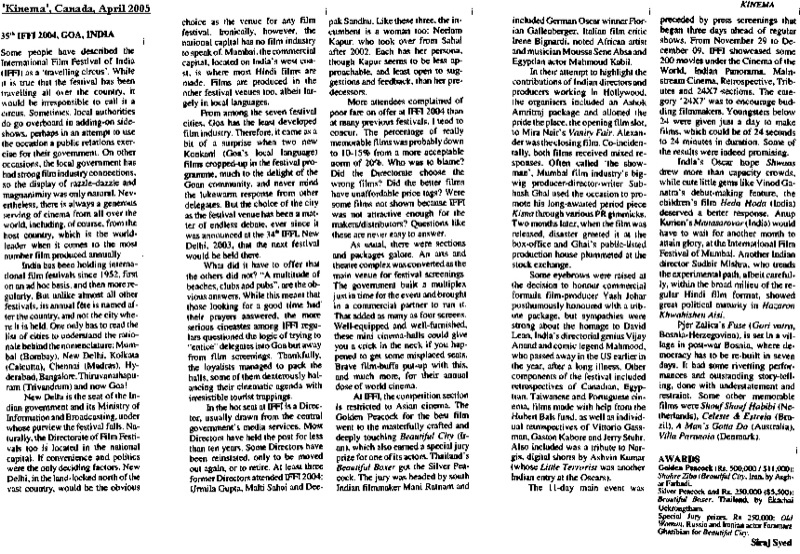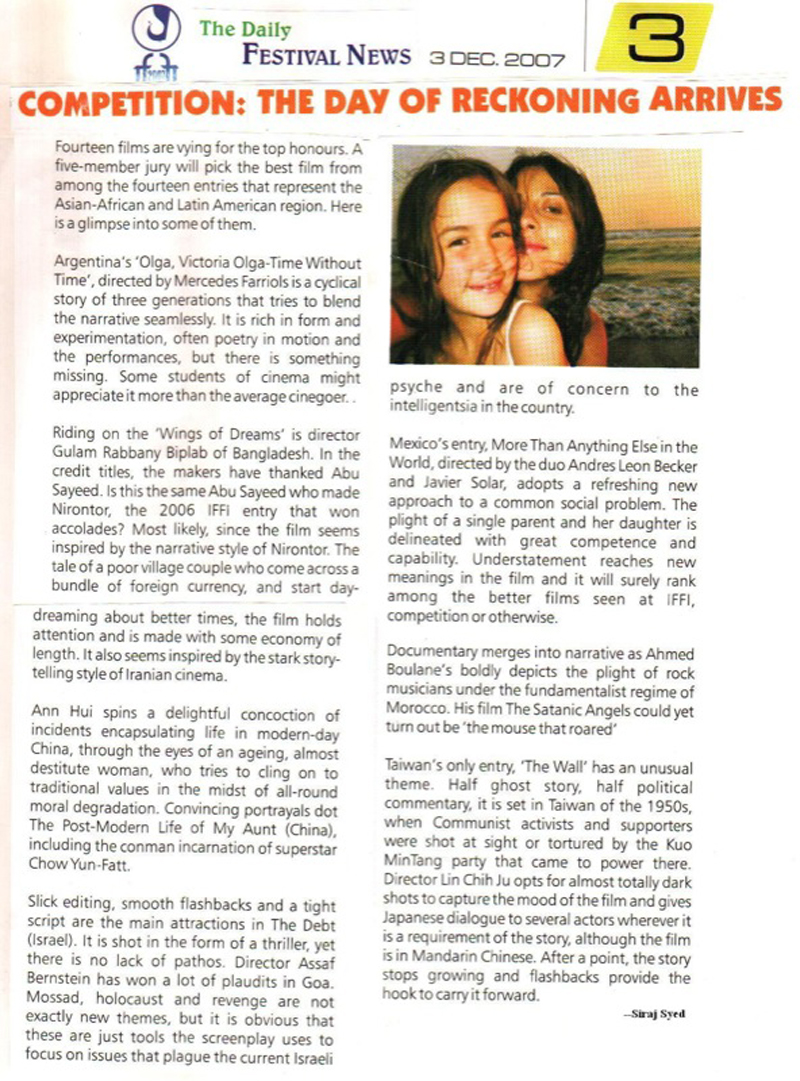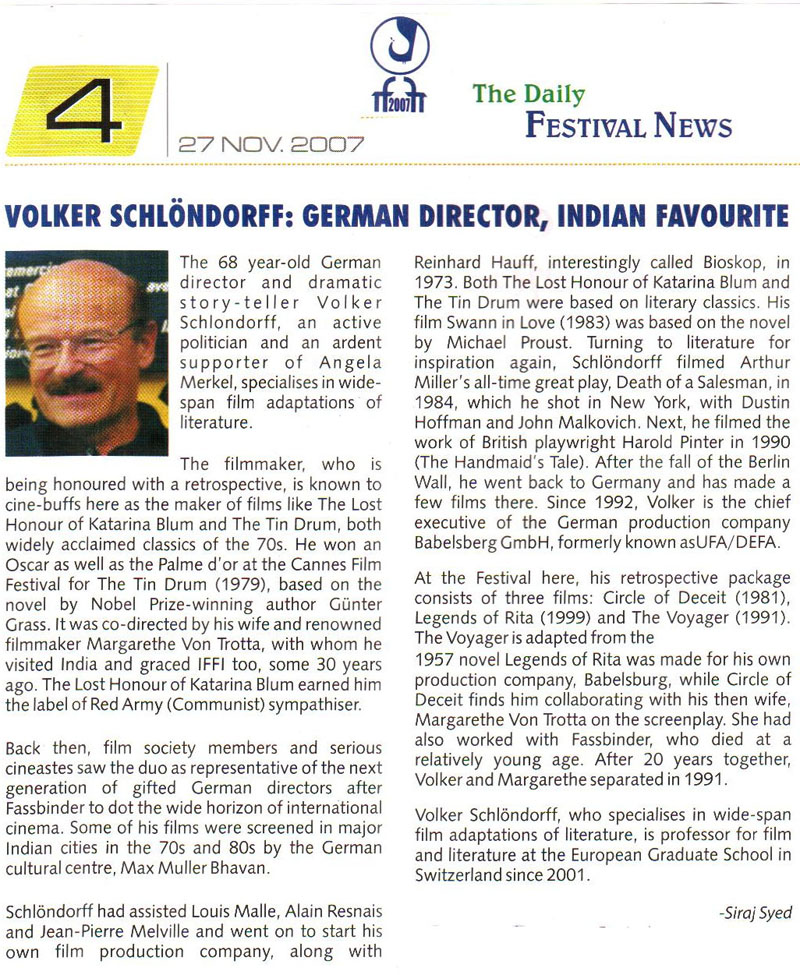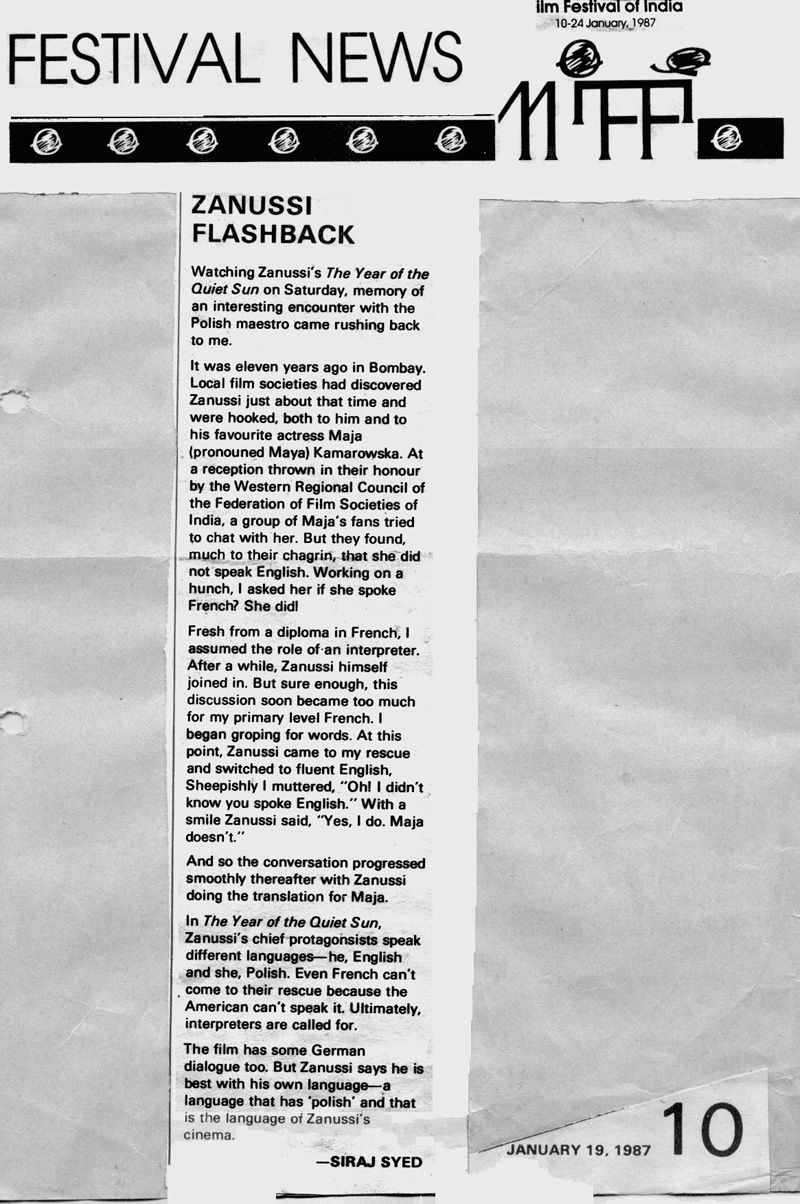|
|
||
|
Pro Tools
FILMFESTIVALS | 24/7 world wide coverageWelcome ! Enjoy the best of both worlds: Film & Festival News, exploring the best of the film festivals community. Launched in 1995, relentlessly connecting films to festivals, documenting and promoting festivals worldwide. Working on an upgrade soon. For collaboration, editorial contributions, or publicity, please send us an email here. User login |
IFFI Goa 2015, Festival Diary, VIII: Did the best ones win?
IFFI Goa 2015, Festival Diary, VIII: Did the best ones win? Without any doubt, my favourite for Best Picture was Embrace of the Serpent (Colombia) directed by Ciro Guerra. The Jury, too, found the black and white film about the Amazon, its rape by greedy foreigners and the destruction of the mythical but pristine lives of its native inhabitants “mind-blowing”, which is reason for feeling vindicated. This is the eighth or ninth time, out of eleven IFFIs at Goa, that my pick for the Golden Peacock winner co-incided with the Jury’s verdict, which makes it ‘not a bad record’, doesn’t it! Born in 1981, cinematographer-writer-director Guerra studied film and television at the National University of Colombia. After directing four short films, he wrote and directed Shadow Walker, his first feature, which was selected in more than 60 film festivals around the world, including Cannes. The Wind Journeys, his second feature, was a road movie, looking to foster a closer relationship between the viewer and Caribbean music. Embrace of the Serpent, Official Selection, at the Directors' Fortnight, Cannes, this year, tells the epic story of first contact, meeting, approach, betrayal, and possible friendship that transcends life, between Karamakate, an Amazonian Shaman, the last survivor of his tribe, and two scientists, who forty years apart, travel the Amazon in search of a sacred plant that could cure their ills. It is based on the diaries of early explorers who travelled the Colombian Amazon, Theodor Koch-Grunberg and Richard Evan Schultes, and co-written by Guerra. You cannot help recalling Werner Herzog’s Aguirra-The Wrath of God, in terms of locale and subject, but the inspiration must cease there. ‘Best film’ was clearly deserved, but so were ‘best director’ and ‘best actor’. The only reason Guerra did not get the director’s prize must have been the need to be socialistic and distribute the prizes, rather than club them all together. EOTS actors Jan Bijvoet, Antonio Bolivar Brionne Davis , Yauenkü Migue and Nicolás Cancino could each walk away with an acting honour. That was not to be, as other options were considered and selected.
British Film director Peter Greenaway bagged the award for Best Director, for Eisenstein in Guanajuato (EIG), which has a Dutch producer of Indonesian extraction. A visual spectacle of form and style, it was the chronicling of a chapter in the life of Russian director Sergei Eisenstein, known for the all-time classic, Battleship Potemkin. (His surname is often mis-read as Einstein, after his almost namesake, the great American scientist, a fact addressed in the film too). Russian archives reveal that he was born in 1898, in Latvia, as Sergei Mikhaylovich Eisenstein, of Jewish descent (through his paternal grandparents). His father worked in ship-building, until 1910, when the family moved to St. Petersburg, where his training as an architect and engineer had a great influence on his future film-making. Watching the insurgent crowds during the 1917 October revolution bearing down on the Winter Palace of the Czars in St. Petersburg, Eisenstein foresaw his future. He enlisted in the Red Army, helped organise and construct defenses and, as his first step in his career, produced entertainment for the troops. In 1920, having decided that a military life was not for him, he entered the Proletkult Theater (the Theater of the People) in Moscow as an assistant stage designer, where he quickly became a co-director. Eisenstein's first film, the revolutionary Strike, was produced in 1924. It recounts the repression of a strike by the soldiers of the Czar. Eisenstein juxtaposed shots of workers being mowed down by machine guns with shots of cattle being butchered in a slaughterhouse. The effect was striking, but the objective reality was falsified. Thus, he introduced a new editing form, the ‘montage of attractions’, in which arbitrarily chosen images, independent from the action, would be presented not in chronological sequence, but in whatever way would create the maximum psychological impact, in stark contrast with the American-style ‘narrative montage’. In 1925, in order to commemorate the Russian Revolution of 1905, the Communist Party commissioned the renowned film Potemkin (also called Battleship Potemkin). The film was made in the Black Sea port of Odessa. In 1958 it was voted the best film ever made, by an international poll of critics. Eisenstein's next film was the two hour film, October or Ten Days That Shook the World, dealing with the shifts of power between the 1917 February and October revolutions, Lenin's entering the scene and the struggle of the Bolsheviks with their opponents. Greenaway uses this title to give his present film an alternate name, Ten Days That Shook Eisenstein. Continually seeking to expand the film-making craft, Eisenstein drew upon his early interest in Japanese Kabuki theatre, Noh drama and their use of masks in his last film, Ivan the Terrible. During World War II, Eisenstein began work on this epic film about the 16th-century Czar, Ivan IV, whom Stalin admired. One battle scene, with Ivan’s close-up diagonally bisecting the frame in the foreground, remains an indelible image. Before he could finish the third part of the film, Eisenstein died, a few days after his 50th birthday. But before his death, he had made a trip to Hollywood, and was commissioned to make a film tentatively titled Que Viva Mexico, in Mexico. During the shooting of this film, Eisenstein, apparently a latent homosexual, entered into a relationship with his local Mexican contact. He exposed hundreds of thousands of feet of film raw stock negative, but the film was never edited, completed or released. Greenaway has explored the sexuality in great, graphic detail, as his wont (The Draughtsman’s Contract; The Cook the Thief, His Wife and Her Lover—both films shown at earlier IFFIs). To me, this obsession with nudity and homosexuality detracts from the remarkable angles, excellent use of split-screen technique and some robust camera movements that underscore Greenaway’s directorial skills.
I would have given the Best Director award, albeit based on a thin margin, to Barcelona-based Julia Vargas-Weise (Sealed Cargo/Bolivia). Shekhar Kapur, Chairman of the Jury, said that he has been a Greenaway fan since the times when he was an accountant in London, so he might not have wanted to tilt the scales away from Greenaway. (There is a problem with chronology, though. Kapur had moved to India in the mid-70s, while Greenaway made his first feature in 1980. Perhaps Kapur was referring to his documentary films, beginning 1962). As it happened, Julia, a writer, actress and photographer, besides a director, had to be content with the Special Jury award. Sealed Cargo is an absurd tale about a cargo train under the care of a railroad engineer and three policemen, with an innocent undercover woman passenger, that carries a hermetically sealed load, presumably toxic waste, that turns out to be cursed. They all seek their destiny on the Bolivian Altiplano in an unexpected adventure, during which the characters are attacked by enraged towns-people, betrayed and deceived, in ways that change their lives and affect the whole country. Seldom has an absurd black comedy, shot in an action thriller style, made so much sense, and dealt with a grave international issue like pollution in such a riveting manner. Vargas-Weise studied photography in Switzerland and is probably the first Bolivian woman to achieve international fame as a photographer.
Two days before the awards were announced, I met Serbian director Goran Radovanovic in the Maquinez Palace courtyard, which had been converted into an outdoor restaurant-cum-beer bar for IFFI 2015, and told him that his film Enclave was among the top five films I had seen at IFFI this year, so far. In the end, it was one of the five that bagged awards. The Special Mention Award was less than what the film deserved, but competition was hot. EOTS and EIG managed to pip Enclave at the post. French actor Vincent Lindon (56, also director-writer) won the best Actor (male) award for The Measure of a Man, which was screened on the very last day, a mere four hours before the closing ceremony. I could not see it, so no comment on the choice. The Best Actor (Female) award was shared by five actors (“actresses”, if you please, insisted host Kabir Bedi) of the Turkish film Mustang. Set in a remote Turkish village, Mustang depicts the life of five young orphaned sisters, and the challenges they face, growing up in a highly conservative society. Gunes Sensoy, Doga Doguslu, Tugba Sunguroglu, Elit Iscan and Ilayda Akdogan were awarded the Silver Peacock(s) at the ceremony, in absentia. This five-in-one must surely be unprecedented in IFFI history, and well-deserved too. As Kapur reminded us, the chemistry the five girls brought to the screen, especially when they were together in any scene, was palpable and electrifying.
An additional award, instituted this year, the ICFT-UNESCO Fellini Prize, was given to the Bengali movie Cinemawala by Kaushik Ganguly. The award, presented in collaboration with the International Council for Film, Television and Audiovisual Communication (ICFT), Paris and UNESCO is to be presented to a film which reflected the ideals of peace, tolerance, non-violence and friendship, promoted by UNESCO. Cinemawala is a laboured film, with ostensibly noble intentions, which could garner nothing at the main awards. Point is, what or who was it competing against, for this prize? 03.12.2015 | Siraj Syed's blog Cat. : BATTLESHIP POTEMKIN Bolivia Cinemawala Ciro Guerra Doga Doguslu Eisenstein in Guanajuato Elit Iscan Embrace of the Serpent Enclave Goran Radovanovic Gunes Sensoy Ilayda Akdogan Ivan the Terrible Julia Vargas Weise mustang Peter Greenaway Que Viva Mexico Sealed Cargo Sergei Eisenstein The Measure of a Man Tugba Sunguroglu Vincent Lindon Werner Herzog FESTIVALS
|
LinksThe Bulletin Board > The Bulletin Board Blog Following News Interview with IFTA Chairman (AFM)
Interview with Cannes Marche du Film Director
Filmfestivals.com dailies live coverage from > Live from India
Useful links for the indies: > Big files transfer
+ SUBSCRIBE to the weekly Newsletter Deals+ Special offers and discounts from filmfestivals.com Selected fun offers
> Bonus Casino
User imagesAbout Siraj Syed Syed Siraj Syed Siraj (Siraj Associates) Siraj Syed is a film-critic since 1970 and a Former President of the Freelance Film Journalists' Combine of India.He is the India Correspondent of FilmFestivals.com and a member of FIPRESCI, the international Federation of Film Critics, Munich, GermanySiraj Syed has contributed over 1,015 articles on cinema, international film festivals, conventions, exhibitions, etc., most recently, at IFFI (Goa), MIFF (Mumbai), MFF/MAMI (Mumbai) and CommunicAsia (Singapore). He often edits film festival daily bulletins.He is also an actor and a dubbing artiste. Further, he has been teaching media, acting and dubbing at over 30 institutes in India and Singapore, since 1984.View my profile Send me a message The EditorUser contributions |




















